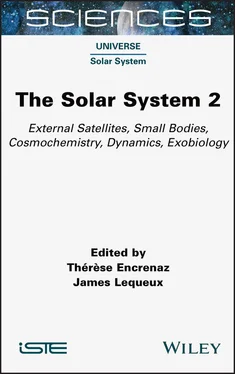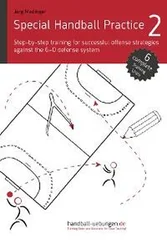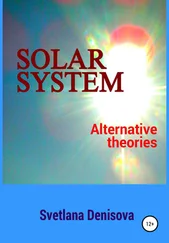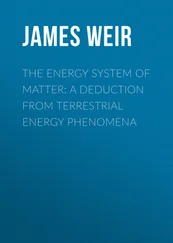1 Cover
2 Title Page SCIENCES Universe , Field Director – Fabienne Casoli Solar System , Subject Head – Thérèse Encrenaz
3 Copyright First published 2021 in Great Britain and the United States by ISTE Ltd and John Wiley & Sons, Inc. Apart from any fair dealing for the purposes of research or private study, or criticism or review, as permitted under the Copyright, Designs and Patents Act 1988, this publication may only be reproduced, stored or transmitted, in any form or by any means, with the prior permission in writing of the publishers, or in the case of reprographic reproduction in accordance with the terms and licenses issued by the CLA. Enquiries concerning reproduction outside these terms should be sent to the publishers at the undermentioned address: ISTE Ltd 27-37 St George’s Road London SW19 4EU UK www.iste.co.uk John Wiley & Sons, Inc. 111 River Street Hoboken, NJ 07030 USA www.wiley.com © ISTE Ltd 2021 The rights of Thérèse Encrenaz and James Lequeux to be identified as the authors of this work have been asserted by them in accordance with the Copyright, Designs and Patents Act 1988. Library of Congress Control Number: 2021940272 British Library Cataloguing-in-Publication Data A CIP record for this book is available from the British Library ISBN 978-1-78945-034-7 ERC code: PE9 Universe Sciences PE9_1 Solar and interplanetary physics PE9_4 Formation of stars and planets
4 Preface
5 1 Satellites and Rings of the Giant Planets
1.1. Introduction
1.2. Jupiter’s satellites
1.3. Saturn’s satellites
1.4. The satellites of Uranus and Neptune
1.5. The rings
1.6. References
6 2 Comets, Asteroids, and Dwarf Planets
2.1. Comets
2.2. The “historical” asteroids
2.3. The “new” asteroids
2.4. The dwarf planets
2.5. References
7 3 Meteorites and Cosmochemistry
3.1. Rocks falling from the sky
3.2. Origin of meteorites
3.3. Planetary differentiation and groups of meteorites
3.4. Chondrites and the origin of the Solar System
3.5. Differentiated meteorites
3.6. Witnesses to the formation and evolution of the Solar System
3.7. References
8 4 Formation and Dynamic History of the Solar System
4.1. Introduction
4.2. Laws of motion of the planets and satellites
4.3. The two-body problem
4.4. The three-body problem
4.5. Perturbations and resonances
4.6. Stability and chaos in the Solar System
4.7. Orbits in relation to a flattened body
4.8. Tidal effect
4.9. Nongravitational forces and orbits of small bodies
4.10. Formation of planetary systems
4.11. References
9 5 Origin of Life and Extraterrestrial Life
5.1. Definition of life
5.2. The appearance of life on Earth
5.3. Life elsewhere in the Solar System
5.4. How can life be detected on exoplanets?
5.5. Communicating with other civilizations?
5.6. References
10 6 Methods for Studying the Solar System
6.1. History
6.2. Observational techniques
6.3. Computer simulations
6.4. References
11 Appendix
12 Glossary
13 List of Authors
14 Index
1 Chapter 1 Figure 1.1. Main satellites of the Solar system at scale (source: Wikimedia Comm...
Figure 1.2. Ocean worlds in the Solar system. The mass of the water in liquid or...
Figure 1.3. The Galilean satellites of Jupiter, aspects of their surface and the...
Figure 1.4. Io. For a color version of this figure, see www.iste.co.uk/encrenaz/...
Figure 1.5. Models of the interior of Europa with the presence of a liquid or ic...
Figure 1.6. (a) Global geographical map of Ganymede; (b) mosaic of images of Gan...
Figure 1.7. A diagram of the lunar system of Saturn and its system of rings. Abo...
Figure 1.8. (a) The atmosphere of Titan; (b) the temperature profile measured by...
Figure 1.9. Seasonal variations in the temperature and composition of Titan duri...
Figure 1.10. The surface of Titan and some of the major discoveries made by the ...
Figure 1.11. The surface of Enceladus seen by Cassini, with the “tiger stripes” ...
Figure 1.12. (a) Mass spectrum of a plume on Enceladus and (b) a model of its in...
Figure 1.13. Natural satellites of the giant planets and other non-planetary obj...
Figure 1.14. Drawings of Saturn by different observers in the 17th century, befo...
Figure 1.15. The four ring systems of the giant planets and the near satellites....
Figure 1.16. Daphnis and its wave on the edge of the Keeler division, inside the...
Figure 1.17. Exterior edge of the B ring confined by 2:1 resonance with Mimas an...
Figure 1.18. Neptune’s rings seen from the south pole (source: (Pater 2015), tha...
Figure 1.19. Occultation of a star by the Chariklo system, observed on June 3, 2...
Figure 1.20. Crest of matter on the surface of Iapetus (source: NASA/JPL-Caltech...
Figure 1.21. View of Saturn from the Cassini probe in natural colors (as the hum...
Figure 1.22. Outer section of Saturn’s A ring with a density wave (DW) and a spi...
Figure 1.23. Possible detection by transit of an exo-ring around a planet of the...
2 Chapter 2Figure 2.1. An active comet seen from a distance. The comet C/1995 O1 (Hale-Bopp...Figure 2.2. An active comet seen from close up. The comet 67P/Churyumov-Gerasime...Figure 2.3. The sungrazing comet C/2012 S1 (ISON) as seen by the Soho space coro...Figure 2.4. D/1973 F2 (Shoemaker-Levy 9), the comet (if it is one) that was dest...Figure 2.5. The nuclei of the comets observed by space missions, represented at ...Figure 2.6. The impact of the Deep Impact probe on the nucleus of 9P/Tempel 1 on...Figure 2.7. The “neck” of comet 67P/Churyumov-Gerasimenko, in the region connect...Figure 2.8. Changes on the surface of 67P/Churyumov-Gerasimenko detected by Rose...Figure 2.9. Studies of the nucleus of the comet 67P/Churyumov-Gerasimenko: geome...Figure 2.10. Sublimation rate for some molecules of cometary ices, as a function...Figure 2.11. The evolution of production rates for different molecules observed ...Figure 2.12. Velocity of expansion and temperature of the atmosphere for a comet...Figure 2.13. Examples of the profiles of molecular lines observed by radio. For ...Figure 2.14. Photolytic process in a cometary atmosphereFigure 2.15. Examples of cometary spectra showing the lines of several moleculesFigure 2.16. Water vibration bands observed in infrared by the ISO satellite in ...Figure 2.17. Cometary molecules observed remotely using spectroscopy and their a...Figure 2.18. An example of mass spectra: molecules from the water family observe...Figure 2.19. The composite spectrum from visible to UV for the comet 103P/Hartle...Figure 2.20. The D/H ratio observed in cometary water. Many of the measurements ...Figure 2.21. The dynamics of a dust tail. The synchrones are in red and the synd...Figure 2.22. A picture of the comet 2P/Encke obtained at a wavelength of 11.5 μm...Figure 2.23. The spectrum in the mid-infrared of the comet C/1995 O1 (Hale-Bopp)...Figure 2.24. Traces of dust grains from the comet 81P/Wild collected in aerogel ...Figure 2.25. Two grains of cometary dust collected by Rosetta/Cosima from 67P/Ch...Figure 2.26. The disconnection of the plasma tail from Halley’s comet on March 1...Figure 2.27. Portrait of Giuseppe Piazzi and the cover of his book announcing th...Figure 2.28. The main belt and the Trojan asteroids (source: Wikimedia Commons)....Figure 2.29. The main families of asteroids (source: Wikimedia Commons). For a c.
Читать дальше












